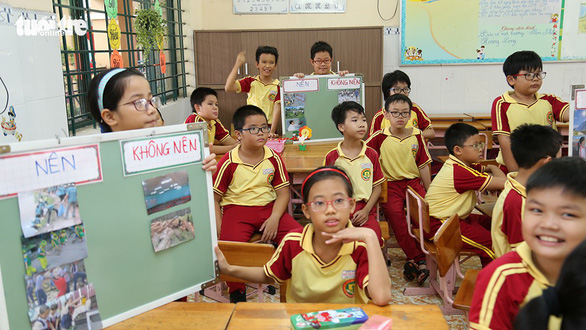Nearsightedness is becoming increasingly common among children in Vietnam, as it is no longer rare to see kids with double-digit myopia, doctors say.
Doctor Vu Anh Tuan, who works at the Hanoi Eye Hospital, said he has examined many children with myopia of -10 D or even greater.
But there is one special case Tuan will never forget, when he met a kid with a high myopia of -30 D.
Severe myopia can lead to partial or complete blindness, as well as other eye diseases, Tuan said.
“Mild myopia of less than -6 D is easier to treat, while higher levels of short-sightedness are also treatable but the success rate is much lower,” Tuan said.
Echoing the view of doctor Tuan, doctor Pham Ngoc Dong, vice-director of the National Hospital of Ophthalmology in Hanoi, said the number of nearsighted patients, especially children, at his infirmary has dramatically increased in recent years.
Dong believes that the main cause of this issue is the overexposure to screens and electronic devices.
A recent survey on more than 1,500 children found that their screen times all exceeded the recommended daily limit of two hours.
Specifically, while most elementary school student breached the limit on weekends, older students did so throughout the week.
There are now around three million Vietnamese students with eyesight problems, most of whom are myopic, Tuan said, citing statistics from different surveys.
Another survey showed that 55 percent of middle school students in Ho Chi Minh City were nearsighted, and the figure in Hanoi was a bit lower, 50 percent.
But what concerns doctors even more is that there are currently not enough measures taken to tackle myopia in children.
For instance, there are not many places for children to play sports or just be physically active instead of being glued to their mobile phones and computer screens.
Many busy parents also allow their children to play with electronic devices, which increases the risk of myopia.
Myopia, commonly known as short-sightedness or nearsightedness, is an eye disorder where light focuses in front of, instead of on, the retina, causing distant objects to be blurry while close objects appear normal.
There are around 1.4 billion short-sighted people worldwide, accounting for 20 percent of the global population.
The number of nearsighted people in Asia is two times that in Europe, and 4.5 times the figure in Africa.
Like us on Facebook or follow us on Twitter to get the latest news about Vietnam!


















































